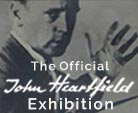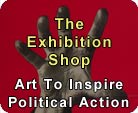About John Heartfield Family & Personal Life. His Grandson Answers Questions From Exhibition Visitors.
Visitors Ask About John Heartfield
His Grandson Shares Personal Memories Of His Famous Artist Grandfather
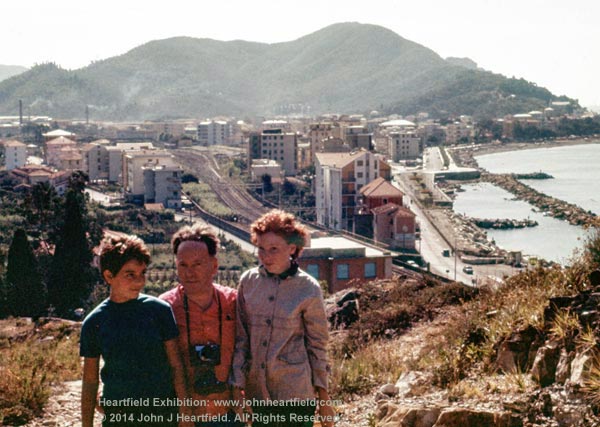
(L-R) John J Heartfield, John Heartfield, Catherine Jacobson, Sestri Levante, Italy 1960s. Image: John J Heartfield Collection
Since 2011, I’ve received questions about my famous grandfather. Many exhibition visitors write to me asking about my grandfather’s personal life because they know I was able to spend time with him. Some questions come from art scholars. Several of the questions below were submitted by Meral Bostanci, who presented her dissertation on John Heartfield to The Board of Graduate Studies Conseil at Isik University in Istanbul, Turkey. You can read about Meral and her groundbreaking work in Turkey in the ART SCHOLARS section of the exhibition.
I don’t provide an exact record of known events or precise dates with these answers. They are based on my memories of my grandfather and my personal observations. Much more information about my grandfather’s life and work is available in the CHRONOLOGY section of the exhibition.
I’ll add to this section as I continue to study the great deal of material in my personal collection, The John J Heartfield Collection. So please come back often.
Visitor Question: Please write more about John Heartfield and his family. How are you related to him?
I am the only surviving paternal grandson of Dada artist, political art pioneer, graphic design genius, and groundbreaking stage designer John Heartfield.
My grandfather, John Heartfield, had two children: My father, Tom George Heartfield, and my aunt Eva Sondermeijer.
My father, Tom George Heartfield, emigrated to America after living with my grandfather in Prague. My father joined the American Army after Pearl Harbor. He could speak seven languages so his job in the army was to interrogate prisoners of war. My father, an American Army soldier, met my mother, Lina Adelina Heartfield, an Italian Partisan freedom fighter, when his Allied Army Unit helped partisans liberate my mother’s hometown of Sestri Levante, Italy.
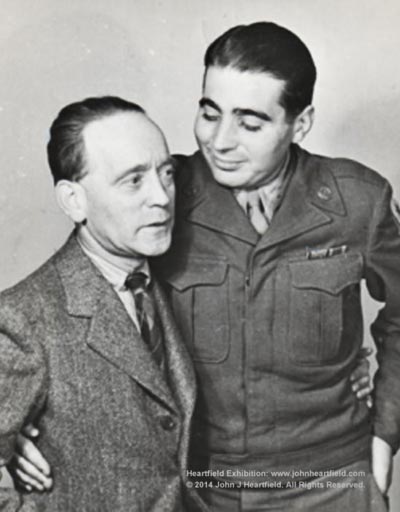
A proud John Heartfield with his American soldier son, Tom George. The pacifist Heartfield never wanted his son to be a soldier, but war was the only way to end The Third Reich.
Image: John J Heartfield Collection.
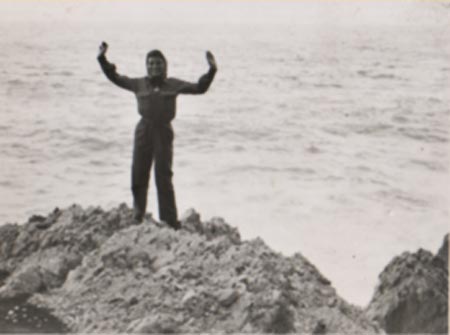
Tom Heartfield's wife, Italian Partisan Lina Heartfield.
Image: John J Heartfield Collection.
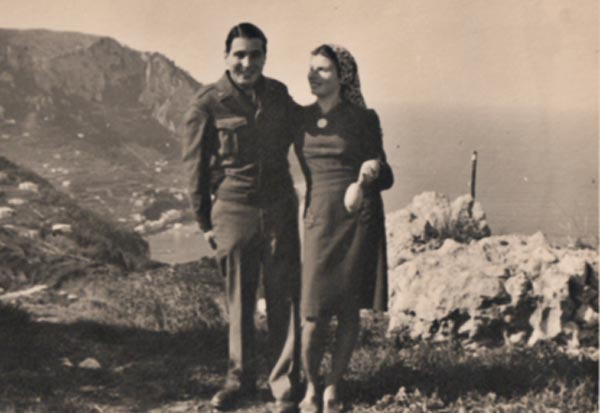
John Heartfield's son, American soldier, Tom Heartfield, and Italian Partisan wife, Lina Heartfield on top of the mountain that separates the Italian towns Sestri Levante & Cavi, Italy.
Image: John J Heartfield Collection.
My mother fought against the German and Italian Fascists who had taken over her hometown. My father fell in love with Italy at the same time he fell in love with my mother. My mother’s energy and good nature charmed my grandfather. She knew he was a hero. They became close. He treated her like a beloved daughter.
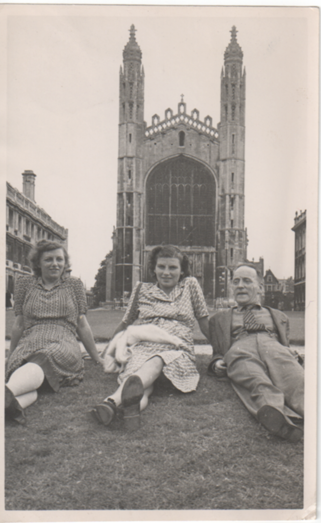
(L-R) Gertrud Fietz, Daughter-in-Law Lina Heartfield, John Heartfield
Image: John J Heartfield Collection.
The story of how my parents met was as cinematic as many of the events in my grandfather’s life story. It involves the intercession of a natural force of a man named Tarzan, a Partisan rightly feared by the Germans. He persuaded my mother, by brandishing the two machine pistols slung over his shoulders, to attend a festa (Italian party) after their town’s liberation. The partisans were planning to shave the head of a good friend of my mother for the crime of consorting with a young German officer. My mother didn’t want to see it, but Tarzan could be very persuasive. My mother and father met at the festa. My beloved Italian grandmother objected because my father was German by birth, but he was an American citizen and soldier. Years later, my Italian family grew to love both my father and my grandfather. My mother and my father have since passed away.
Tom and Lina had three children. Soon after his birth, my brother, Malik, died of pneumonia in an English hospital. My older sister, Catherine, and I were born in the United States.
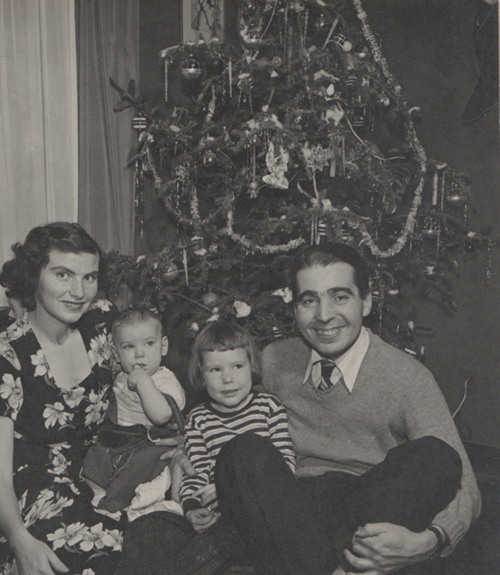
(L-R) Lina Heartfield, John J Heartfield, Catherine Heartfield, Tom George Heartfield.
Image: John J Heartfield Collection.
Many people close to my grandfather called him “Johnny” or “Jonny.” I sometimes refer to him in The John Heartfield Exhibition with those nicknames. My Italian Family affectionately referred to him as “Professore” (Professor). On this website, I always attempt to refer to myself as John J Heartfield to distinguish myself from my famous grandfather, John Heartfield.
My grandfather’s third wife and widow Gertrud (everyone in our family called her “Tutti”) was my adopted grandmother. Gertrud and I were close and became even more so after my grandfather’s death in 1968. We often wrote letters and I keep of a large collection of the ones she sent to me and my father. Soon I’ll them soon in The John Heartfield Exhibition.
Visitor Question: The Official John Heartfield Exhibition is an ambitious project. How is the exhibition funded? Can I help the exhibition grow in any way?
To date, I have worked on the design, interface, and programming of the John Heartfield Exhibition entirely on my own. For support with facts, dates, and events, I rely on John Heartfield scholars.
Please write to me if you’re interested in displaying your work (of any kind) displayed on the exhibition.
Visitor Question: How is The Official John Heartfield funded? What can I do to help?
To date, my wonderful wife, Michelle, and I have provided the bulk of funding to keep the exhibition online and growing. There are two ways you can help the exhibition continue to shine a light on alternate facts, climate change denial, and the spread of fascist political tactics.
Visit The John Heartfield Exhibition Shop. The quality of the merchandise and art reproduction has drawn raves from everyone who purchased items from the shop. The shop is adding new items all the time. So please check in often.
If you always support the exhibition with any amount on the Contribute To Reveal The Real News page. It’s quick, secure, and private.
Visitor Question: Were you able to meet and spend time with your grandfather? What was he like?
In the nineteen fifties and sixties, my family traveled to Europe to spend summers with my mother’s family in Sestri Levante and Cavi di Lavagna on the Italian Riviera. We spend time with my grandfather, John Heartfield, and Gertrud (“Tutti”) in Italy and Germany when he could get a temporary visa from East German (GDR). My father supported my grandfather financially throughout his life with as much money as we could afford. He saved and sent money to my grandfather to make these visits possible. My father worked in the printing industry as a typesetter and my mother was a waitress in a nearby bowling alley.
If I had to describe my grandfather in two words, they would be passionate and energetic.
He was passionate about his opinions. I vividly remember a wild shouting match in German between my father and my grandfather that took place on an Italian street corner while my mother, my sister, and I watched from across the street. From the intensity of their voices and hand gestures, a stranger might have thought they were arguing about a matter of life and death. I remember being quite upset.
I turned to my mother and asked, “Mom, what’s wrong?”
My mother said, “Don’t worry. It’s nothing. Grandpa thinks the hotel Daddy picked is too fancy.”
My father and grandfather calmed down not long after. My father idolized his father. One of the most vivid memories of my childhood was walking into the living room and being shocked to find my normally taciturn father sobbing uncontrollably on the couch. He was not a man who cried. That day in 1968 he received word my grandfather had passed away.
I also idolized my grandfather. Although he was capable of vehement emotions, He was always kind and gentle with me. Between visits with each other, he and I exchange letters. I wrote to him about careers I chose for myself (with my parents’ enthusiastic encouragement) that thankfully did not pan out.
Below are photos of my father, Tom, and his father, John Heartfield.
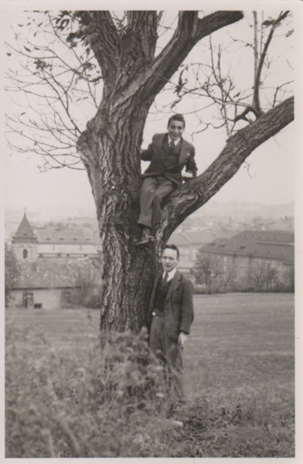
John Heartfield & his son, Tom. Dresden.
Image: John J Heartfield Collection.
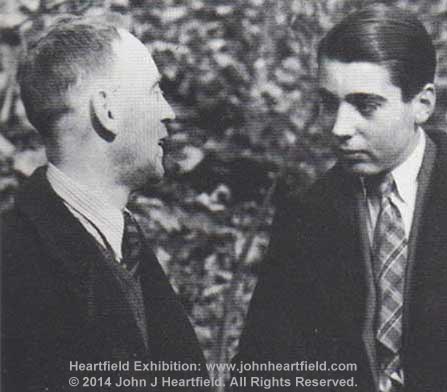
(L-R) John Heartfield and his son, Tom, in Prague, 1937.
Image: John J Heartfield Collection.
Visitor Question: Would you please share a memory that would give me a little insight into his personality?
As I wrote, my beloved Italian grandmother, aunts, and cousins called my grandfather “Professore” (Professor). Although his Italian language skills were not strong, he managed to be as gregarious with Italian speakers as he was with almost everyone of good conscience. He loved meeting and talking with people. He wasn’t a man to “put on airs.” There was never a hint he thought he should be treated differently in some way because of his artistic accomplishments. He was a warm and approachable man, much loved by my family and friends and our acquaintances.
Visitor Question: Because of his ill health before he died, did he have any physical or mental changes or any extraordinary behavior? Did you know of any mental changes he suffered due to ill health just prior to his health?
This is a somewhat strange question. John Heartfield exhibited “extraordinary behavior” throughout his life. My grandfather’s passion to expose hypocrisy and political insanity drove him to risk his life again and again. His ceaseless energy gave him the ability to produce his powerful political art under the most challenging conditions imaginable.
If you’re asking if he lost his memory or his ability to think clearly during his final years, I would have to state that, to my knowledge, he remained cogent until his death.
Shown here is a note that Johnny wrote to my father on the inside of a book cover in 1967, one year before Johnny’s death in 1968. It’s clear that his handwriting is strong and his mind is clear.
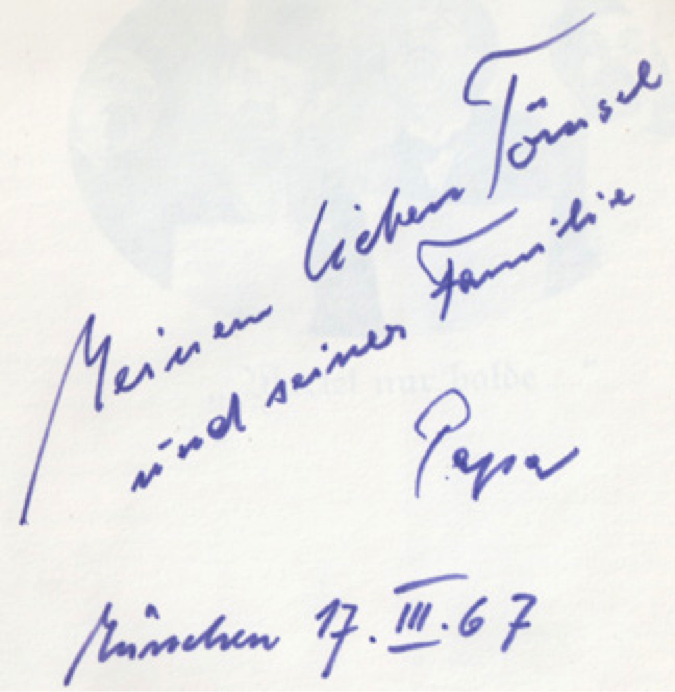
Book inscription from John Heartfield to his son, Tom. Berlin 1967.
Image: John J Heartfield Collection.
Videos of him at exhibitions in his later years demonstrate quite clearly that he remained articulate, speaking in his quick emphatic verbal style.
Visitor Question: As far as you can remember, can you please describe John Heartfield in his 60s? Can you paint a picture of John Heartfield, an excited character who challenged the ruling people of his time with his sarcastic montages, when everything [the reign of fascism] settled down in the 60s?
John Heartfield did not believe that “everything settled down in the sixties.” He remained vocal about what he considered insane political views and actions up to his final days. Although he wasn’t able to express his political views in East Germany (GDR) because there was no venue to distribute his work such as the AIZ, he created art, such as the photomontage that warned of the dangers of the atomic bomb in the arms race.
My grandfather was always, above all, a pacifist. He labeled himself “an old pacifist” in his senior years. He never advocated violent revolution to my knowledge. It’s my belief that his view of communism changed a great deal later in life. In his early years, he believed that communism was the economic system that offered the world’s best hope for human equality and world peace.
Following the outrageous treatment he received from the totalitarian regime of East Germany and the terror of the Stalin regime where he lost longtime friends, he was disappointed by the way the reality of communism differed from the idealistic, and in my opinion, naïve, political theory.
When my grandfather had no choice but to return to East Germany after his exile in England, he received unforgivable treatment from the East German Government. He was under suspicion by the Stasi because of the length of time he had spent in a capitalist country. There was also the absurd fact that Johnny’s dentist was under suspicion. There’s an old saying, “Just because you’re paranoid, it doesn’t mean you aren’t being watched.” In Italy, my father always reminded me to “not talk loudly with grandpa about his life or politics in East Germany.”
The East German Academy of the Arts (Akademie der Künste) denied him admission for six years (1950 to 1956). His health deteriorated. He could not function as an artist. It was only through the intervention of Bertolt Brecht and Stefan Heym that JOhn Heartfield was formally admitted to the East German Akademie der Künste (Academy of the Arts) in 1956.
It seems to me we all come to face the folly of our youthful beliefs in our later years.
Visitor Question: The first large American exhibition of your grandfather’s work was at MoMA in 1993 as part of a three city world tour. Do you think American’s point of view with regard to John Heartfield changed after that exhibition?
(NOTE: John Heartfield’s first international show was in Moscow in 1931. There was an exhibition in Paris in 1935, followed by one in New York in 1938. There were several more after the war. (Source: Andrés Mario Zervigón, Associate Director of Art History, Rutgers University).
Regarding the 1993 MOMA exhibition, I can’t speak for the American People. The New York art critics, such as the review in The New York Times, raved about the show. MoMA mounted an outstanding exhibition. You can browse through the excellent MoMA Catalog for the 1993 John Heartfield Exhibition.
I spent many hours strolling through the crowds at the MoMA Exhibition. I saw how thrilled people were to see the amazing originals. Nothing compares to seeing a great work of art molded by the artist’s own hand. Many originals contain not only the touches Johnny added to the final photomontages, but also Johnny’s detailed notes to the rotogravure masters.
Visitor Question: From John Heartfield’s death in 1968 until the 1993 MOMA Exhibition there were no major exhibitions for twenty-five years. It is possible to relate that fact directly to the Cold War. After the demolition of the Berlin Wall, everything was comparatively better. Would you comment on the policies regarding exhibitions of the East German and German Academies of the Arts (Akademie der Künste)?
I do not understand how the Akademie der Künste makes decisions regarding John Heartfield Exhibitions. However, here’s a list of Heartfield Exhibition that was recently given to me by the Akademie der Künste:
1968 London
1969 Berlin/West (NGBK= Neue Gesellschaft für Bildende)
1969 Stuttgart, West Germany
1969 Ville de la Courneuve, France
1970 Copenhagen, Denmark
1970 Södertälje, Sweden
1971 Berlin/East, Akademie der Künste, Ost
1971 Moskau
1974 Paris
1975 Eindhoven, Netherlandds
1976 Berlin/West, Elefantenpress
1976 Skopje, Macedonia
1977 Oldenburg, Elefantenpress C.v.Ossietzky-University
1977 London
1978 Venice, Italy
1978 Zürich, Switzerland (Kunstgewerbemuseum )
1979 Berlin/West, Haus am Lützow-Platz
1980 London
1981 Berlin/East, National Gallery (Daumier+Heartfield)
1989 Frankfurt/Main, West Germany, University Library
One goal of The John Heartfield Exhibition is to increase my grandfather’s recognition and renown. The The John Heartfield Exhibition, is a hub for worldwide visitors to share their thoughts about John Heartfield’s life and work. The exhibition also features brilliant modern artists with integrity and courage who work is influenced by John Heartfield.
Art historians assured me that John Heartfield is found on almost every respected list of the twelve most influential artists of the twentieth century. And yet, I constantly meet people (even those heavily involved in the world of art) who tell me they’ve never heard of a German artist named John Heartfield.
Although I haven’t agreed with some policies of the East and West Akademies in the past, I believe that the best way forward is to develop a productive relationship between myself and the Akademie der Künste.
I visited the East German Akademie der Künste shortly after the wall came down. The sheer amount of Heartfield art stored in the Heartfield Archive stunned me. There were not only original photomontages, but literally floors of original art. There were also models of stage sets and sketches.
My efforts to work with the Heartfield Archiv, Akademie der Künste, in the past have been less than successful. However, I continue to hope that the Berlin archive will understand the benefit of cooperation. I’ll keep all my exhibition visitors and social media friends updated on progress.
Visitor Question: Heartfield was a very brave artist. He used arts as a way of quoting his political ideas fearlessly. This choice undoubtedly affected his living conditions and family relations in a negative way. He left his country, he was expatriated, and had to live away from his family. Did any of his family members have any reaction or anger about this?
Obviously, everyone in my family was often concerned about my grandfather’s safety and living conditions.
My father told me that my grandfather, after his time in England, was denied admission to America so he could live with our family and be close to his brother, Wieland. We were all hoping he would live with us as my father’s mother had done until she passed away. My family would have gladly welcomed Johnny into our home. There was always a great joy when we spent time with him and tremendous frustration when it was not possible. However, his immigration to America was not possible. This was a period in American history when American politicians were obsessed with the idea that communists were hell-bent on overtaking the United States.
Although he was often on the run, Johnny remained close to his family, especially my father, Tom, and Johnny’s daughter, Eva. I have many postcards, letters, and books signed with loving messages to “Tömsel” and his family.
Johnny suffered at least two great injustices during his life in my opinion.
The first was his internment in an English concentration camp when he fled Czechoslovakia in 1938, one step ahead of the invading Nazis. England interned him only because he was a German National. Johnny’s health suffered terribly during this period. Photos of him after his release show his gaunt pale appearance.
The second was when my grandfather had no choice but to return East Germany after the war. He was under suspicion by the Stasi because of the amount of time he had lived in England, outside of communist influence. Also, his dentist was under suspicion for political activities. John Heartfield was denied admission to theA kademie der Künste for six years, from 1950 to 1956. This meant that he was denied adequate healthcare, compounding the health problems he suffered in England and most likely shortening his life. He suffered his first heart attack not long after his return. It was because his great friends, Bertolt Brecht and Stefan Heym, insisted that John Heartfield be recognized that he became a member of the East Germany Academy of the Arts.
Visitor Question: John Heartfield pioneered montage techniques that are currently used in a great many areas such as graphic arts and advertising. I believe that he received a doctorate at the university. Apart from these did he get any certificates of appreciation, awards, plates, etc., or any other support from private sector or public corporations hitherto?
I’m very fond of this quote from John Heartfield. When he was offered a teaching job at a Liepzig university, he responded, “Do I have to become a professor?”
I believe that awards, certificates of appreciation meant very little to my grandfather. To believe my grandfather would be impressed by personal or individual awards would be to misunderstand how he viewed the world. There was no doubt in his mind that he wanted to be an artist from his first childhood dreams. Later in life, he risked his life to oppose politicians who twist obvious truths, such as we all created equal, into ugly lies to support their claims to power. My grandfather found his voice in art, truth, and justice. Those were his aspirations.
However, if visitors are interested, my friends who are art scholars tell me that this kind of information is available in the Wieland Herzfelde biography of John Heartfield and the 1993 MoMA Exhibition Catalog.
One of the largest commercial supporters of John Heartfield was Malik Verlag, the publishing house he started with his brother Wieland. John and Wieland were extremely close. There’s certainly a strong argument to be made that the accomplishments of John Heartfield would not have been possible without the support and collaboration of his brother.
Wieland also had a warm close relationship with my father, Tom.
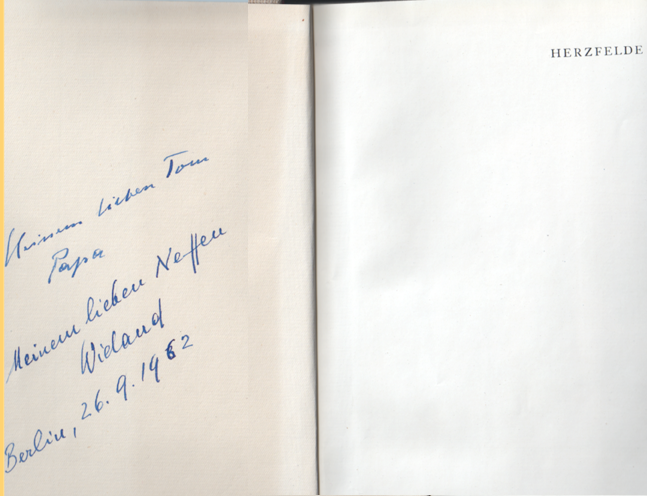
John Heartfield & Wieland Herzfelde Book Inscription to Heartfield's son, Tom, 1962..
Image: John J Heartfield Collection.
My father, Tom George Heartfield, supported my grandfather, Johnny, financially and emotionally. My father sent as much money to Johnny as he could as often as he could.
Visitor Question: Do you think that John Heartfield’s works are still disturbing some people? Have you witnessed any reactions to his work from Neo-nazis or the Ku Klux Klan?
John Heartfield did not risk his life and create his political art to disturb personalities such as Hitler, Goering, and Mussolini. His mission was to expose their insane philosophies and ridicule their hypocrisy to as many thoughtful and reasonable people as possible.
His aim was to wake up his audience. His goal was to have them realize that Fascism was a deeply flawed political ideology that inevitably leads to war and suffering. His genius was that he was able to do that with humor, the juxtaposition of words and images, and a brilliant visual sensibility.
Since I don’t interact with members of Neo-Nazi Groups or members of Ku Klux Klan, I can only imagine how they might react to a Heartfield work famous political art such as Adolf The Superman. Swallows Gold and Spits Junk.
Without referring to a specific group or personality, it’s clear to me that Heartfield’s brand of political satire is as relevant today as it was in the 1930s. The United States Supreme Court decision Citizens United allows modern politicians to “swallow gold and spit junk” just as Hitler once did.
Visitor Question: According to resources, it is not known what happened to Franz Herzfelde’s wife, Alice Stolzenberg. Do you have any information about where she was until her death in 1911 or where she lived?
According to Professor Andrés Mario Zervigón, author of the wonderful book, John Heartfield and The Agitated Image, Alice lived in Berlin shifting between a mental institution and a boarding house.
There’s no doubt my grandfather’s mother and father suffered from mental disorders of varying severity. Sadly, their story is not a pleasant one.
Visitor Question: A visitor quotes a book(?): “Then, in 1968, after revisiting London, he (Heartfield) had a third heart attack and died. His brother, who published a vivid, if slightly doctored account of his life and work, would survive him by twenty years.” Do you agree with this?
It’s a fact that my grandfather passed away in April 1968 from a heart attack and Wieland lived for several years afterwards. I remember walking into our living room in Elmhurst, Queens, New York, one afternoon to find my father crying like a child.
“What’s wrong?” I said.
“Papa’s gone,” he said.
Shortly afterwards, my father traveled to Berlin to attend a celebration of Johnny’s life.
The East Germans treated him like a celebrity. There’s one thing I can’t understand. Under German Law, my father would have only needed to sign a simple document to claim his right to one quarter of Johnny’s estate, which would have included one quarter of his art catalog. Perhaps he didn’t do so because he felt it would endanger Tutti’s position in East Germany. Tutti was my grandfather’s widow and my adopted grandmother. We all appreciated what she did for him in the years after they met in England. Perhaps my father believed the Berlin Wall would never come down. Perhaps his legal rights weren’t made clear to him while he was in Germany. We never discussed it. In fact, I only found out fact’s about my grandfather’s estate after my father had passed away. I can guarantee, however, that if my family had taken possession of some of Johnny’s art at any point, then originals of his work would be available at this moment to museums such as The Getty Museum, MOMA, and the Holocaust Museum.
Visitor Question: There is almost no information about your grandmother Helene Balzer, your father Tom Heartfield, your uncle George Heartfield etc. Can you make a family tree of four generations starting from Franz Herzfeld finishing with you (as we are interviewing you) with dates of birth and death?
There is almost no information about your grandmother Helene Balzer, your father Tom Heartfield, your cousin George, etc. Can you make a family tree of four generations starting from Franz Herzfeld finishing with you (as we are interviewing you) with dates of birth and death?
An entire family tree will be forthcoming soon in the exhibition. Please check Twitter and Facebook to see when it’s completed and posted.
For the moment, I’ll provide this information. John Heartfield had two childrenhis son, Tom George Heartfield and his daughter, Eva Heartfield (married surname: Sondermeijer). My father, Tom George Heartfield, married Lina Adelina Bo (married surname: Heartfield). They had three children: My brother, Malik, who died in infancy, myself, John Joseph Heartfield, and my sister Catherine Heartfield. My sister, Catherine, and I reside in America. Eva had two children: Bob Sondermeijer and Jolanda Sondermeijer. My sister, Catherine, has a daughter Allision. Wieland Herzfelde had a son, George Herzfelde, who resided in Switzerland. George and I were good friends. I’m saddened to report that George Herzfelde has passed away.
Visitor Question: Was your father, Tom George Heartfield interested in visual arts? Is anyone in your family interested in visual arts? When did your father go to the USA? Was he a political refugee? Why the United States?
My father, Tom Heartfield, truly believed in the American Dream. He was not a refugee. In his youth, he bicycled throughout Europe. He lived for a time with my grandfather in several cities.
My father came to the United States to start a business and make a good life for his family. When America entered World War Two, he joined the American Army. Because he could speak seven languages, he was tasked with interrogating Axis Prisoners. He met my mother, Lina, who was an Italian Partisan (freedom fighter against the fascists) from her hometown of Sestri Levante, Italy.
While my father was in Europe, his business partner back in the states bankrupted his business and ran off with his first wife. My father and his first wife subsequently divorced.
My father and my mother married in Italy and my mother gave birth to a son, Malik. Sadly, while still an infant my brother, Malik, contracted pneumonia and died in an English hospital.
My father and mother emigrated to America. He became a typesetter and a proofreader for a German language newspaper. My father was also very active in his union, eventually spending many hours as a financial officer. However, he did not inherit the artistic DNA of my grandfather.
I’m like my father. My talent, such as it is, is with words. In short, I literally can’t draw a straight line. It’s not widely known that my grandfather was an excellent painter and sketch artist. Talents he used in his work with German playwrights such as Bertolt Brecht and Erwin Piscator.
I studied literature during my first go at a university education. Years later, I earned an undergraduate degree in computer science. Rather than pursuing a doctoral degree in mathematics at the Courant Institute, I applied to the Interactive Telecommunications Program, Tisch School of the Arts, New York University.
The ITP program, chaired by the iconic Red Burns, was one of the first Masters programs in America to meld the visual and sound arts with computer technology.
When I received my masters, I was fortunate to received a Tisch School of the Arts award “for pioneering work in interactive media.”
I am an author of both fiction and non-fiction. The genres that fascinate him are mystery and adventure novels. You can read my short stories, samples of my books, and my articles on the John J Heartfield Author Website. I’ve been writing songs since I was thirteen. My songs and excerpts from the John Heartfield Multimedia Event One Hand! are available on the John J Heartfield Songwriter Website. I’ve programmed and designed everything on those websites. In short, I have a long history of professional visual design.
Inspired by the events of 2016, I began creating Photoshop homages to the work of my grandfather. Some of these are available in the REVEAL ART section of the exhibition.
I’m always searching for corporate or institutional grants to help the work of The John Heartfield Exhibition to expand. If you’ve enjoyed any part of the exhibition, please:
Visit The John Heartfield Exhibition Shop. The quality of the merchandise and art reproduction has drawn raves from everyone who purchased items from the shop. The shop is adding new items all the time. So please check in often.
Or consider a contribution of any amount to Help The Exhibition Expand. It’s quick, secure, and private.
Visitor Question: Did John Heartfield spend time with his own children? Was he a family man? Was he with his children while they grew up? Did you hear ever hear any complaints from your father?
John Heartfield was definitely a family man and deeply loved his children. He lived with his son, Tom, and had great affection for his daughter, Eva. At times, during the war, it became difficult for his family to maintain contact. However, after the war, they came together as often as possible given the constraints of the East German political system. I never heard a word from my father regarding my grandfather that didn’t express the depth and breath of his love and respect for his father.
Visitor Question: Are you aware of any interviews with your grandfather that I could find on Internet and use?
There are many interviews and videos of John Heartfield that are available on You Tube. As I watched many of these videos, I realized that this is a goal I have for The John Heartfield Exhibition. I present a database of interviews and works by artists influenced by John Heartfield’s work.
One way to see many Heartfield videos is to watch my video on YouTube, Born Yesterday, a song I wrote with my grandfather’s montages in mind and access the videos on the right side of the page.
Visitor Question: Do you have favorites out of all of your grandfather’s creations?
I’d have to say I’ve always been fond of two of Johnny’s photomontages. One is “Hitler Swallows Gold and Spits Junk.” Is there a better way to depict how some persons in power spew hatred because of the huge compensation that comes from such activity. The other montage I love is “The Meaning of Geneva.” The simplicity ferocity of the image of a dove impaled on a bayonet is an unforgettable statement of how war brutalizes the innocent. As I’ve mentioned in other places, Johnny loved nature and animals. I’m certain that he used the dove specifically for this point.
Some days it’s difficult to decide which pieces are my favorites. As I continue to add his work to the exhibition, my favorites change from day-to-day.
Visitor Question: Do you own any of his original pieces?
I have a few of his original pieces, including his only surviving oil painting, The Cottage In The Woods. All the pieces are stored in a secure temperature humidity dust-free facility. I would gladly lend out these pieces to responsible institutions to be enjoyed as part of real world John Heartfield Exhibits. I would also like to loan institutions with historic ephemera from my large collection entitled The John J Heartfield Collection.
I tried for many years to challenge the legality of what a part of my family considered the state seizure of his property and his art. However, lawyers told my sister and I that we could not challenge the German Akademie der Künste in a German court.
I remain hopeful. I have taken steps to encourage the Akademie der Künste to engage in a friendly productive mutually beneficial relationship with me so that John Heartfield’s original art can be loaned out to the many major museums that are eager to display it.
Visitor Question: Do you have any special objects, possessions, etc. that remind you of your grandfather?
Yes. I have a wonderful collection of personal photographs, letters, postcards, and even a bronze medal. I’ve given this collection a name: The John J Heartfield Collection. As I have the objects digitized and organized, I will present many of them on The John Heartfield Exhibition.
This collection is at a secure location. It’s available for view by writers, art historians, and academics.
Thank you for these great questions! Please keep them coming. I’ll post my answers here.
